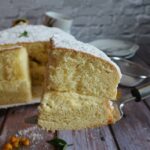
Russian yeast cake "Lakomka" / Nevsky cake
The Russian cake "Lakomka" or Nevsky cake consists of a fluffy yeast dough and the delicate buttercream filling. It tastes soft, creamy and incredibly delicious. Dusted with powdered sugar, the yeast cake is also an eye-catcher in white on the dining table and is perfect both for dessert during the week and for a special occasion. You can easily make it yourself from a few common ingredients using this recipe.
Servings 12
Equipment
- 24 cm x 24 cm large square springform pan
Ingredients
for the dough
- 250 ml milk (lukewarm)
- 100 g sugar
- 3 eggs (room temperature)
- 75 g butter (room temperature)
- approx. 600 g flour
- 25 g fresh yeast
- 1/3 tsp salt
- vanilla
- butter or margarine to grease the baking pan
- vegetable oil to grease the hands
for the cream
- 160 g butter (room temperature)
- 150 g sugar
- 100 ml milk
- 1 egg
- 1 tbsp rum or cognac
for dusting
- powdered sugar
Instructions
- Line the bottom of the baking pan with baking paper and grease the edges with butter or margarine.
Preparation of the dough
- Pour lukewarm milk into a large mixing bowl and dissolve in it 1 tablespoon of sugar (from the total amount indicated) and fresh yeast.
- Add 200 g of flour, stir, cover and let the pre-dough rise in a warm place for 20 minutes.
- Add eggs, the remaining sugar, vanilla and salt to the pre-dough and mix until homogeneous.
- Gradually add the remaining 400 g of flour and knead it into a mushy, very sticky dough. (Follow my tips and tricks for this here at the top of the post).
- Knead butter into the dough and then knead the dough for about 10 minutes. Cover the dough in the mixing bowl with a towel and let it rise in a warm place for 30 minutes. Grease your hands with vegetable oil, knead the dough briefly, cover it again and let it rise in a warm place for another 30 minutes.
- Grease your hands again with vegetable oil, knead the dough and spread it evenly on the bottom of the springform pan. Cover it with a towel in the springform pan and let it rise in a warm place for 30 minutes.
- Bake the yeast cake in a preheated oven at 160 °C top and bottom heat for about 25 minutes and let it cool down afterwards.
Preparation of the cream
- Mix egg and milk in a saucepan with a thick bottom.
- Add sugar and mix it to a homogeneous mass. Put it on the stove, bring it to a boil over medium heat, stirring constantly, and then continue to boil it over medium heat, stirring constantly, for about 2 minutes, until the mixture has thickened a bit. Then take it off the heat and let it cool to room temperature, stirring occasionally.
- Beat softened butter for about 3 - 4 minutes until fluffy and white.
- In small portions, add the cooled cooked mixture to the butter, beating it each time to form a homogeneous, fluffy cream.
- Add rum or cognac and whip again briefly to a homogeneous cream.
Preparation of the cake
- Cut the yeast cake lengthwise into two cake layers, spread the cream evenly on the bottom cake layer, leaving a very small amount of cream for the top of the cake, and place the second cake layer on top of the first. Spread a very thin, translucent layer of the leftover cream over the top and edges of the cake so that powdered sugar can adhere to it later, and refrigerate it for at least 2 hours.
- Now dust the yeast cake generously with powdered sugar.
Notes
- Dry yeast can be used instead of fresh yeast. For the recipe then 8 g of it are needed.
- Be sure to use lukewarm milk and room temperature eggs and butter for the yeast dough.
- To give the dough the right consistency, add the last portion of flour little by little. The amount of flour specified in the recipe may vary. The dough must be mushy and very sticky and not set.
- Since the dough is mushy and very sticky, keep greasing your hands with vegetable oil when working with the dough.
- Use a toothpick to check if the yeast cake is done baking.
- Alcohol in the cream can be omitted.
- Do not spread the cream on the cake layers while they are still warm.
- Alternatively, instead of cutting the yeast cake into two, you can cut it into three cake layers and spread the cream on two of them.
- Note the detailed tips and tricks for making the yeast cake "Lakomka" above in the post.